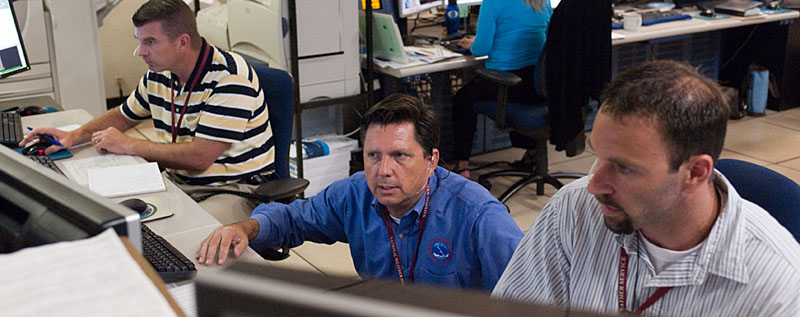
As Alexander Graham Bell once quipped, "When one door closes, another opens." Such is the case with the National Weather Service Southern Region and its Spaceflight Meteorology Group. SMG's 30-year mission to support NASA's space shuttle program came to an end with the successful touchdown of Space Shuttle Atlantis in the pre-dawn hours of July 21.
While a smaller, modified SMG team remains to support the Johnson Space Center and future missions, a handful of its experienced, highly-skilled forecasters will transfer to NWS Southern Region Headquarters in Fort Worth, Texas, to form a core group of Emergency Response Meteorologists. The transfer will launch a pilot project designed to support key local, state and federal emergency managers and other decision makers charged with the protection of life during natural or accidental high-impact events.
"This special group will help the National Weather Service turn to the next page on protection-of-life services to our partners and the public," said Bill Proenza, regional director, National Weather Service Southern Region. "This project represents a vital restructuring of our resources towards providing immediate and strategic weather information to mitigate the loss of life and support the economic well-being of the nation during high-impact events."
When the new team becomes operational this fall, it will replace the Regional Operation Center's older system of using rotating duty officers to help provide operational support for the Southern Region's field offices, the Texas Department of Emergency Management and FEMA Regions IV and VI during high-impact events; and serve as a source of information for NWS Headquarters chain of command. The team will continue to do all that and much more.
"They will also be reaching out to a wide range of federal partners, such as the Environmental Protection Agency, Nuclear Regulatory Commission, Federal Aviation Agency and Transportation Security Administration — just to name a few," said Tom Bradshaw, chief of the Southern Region's Meteorological Services Branch.
With supervisory responsibility for the five-member team, Bradshaw noted the considerable advantage of having such highly-skilled meteorologists to launch the project. But he says that is just the beginning.
"They will be trained in a number of specialized decision support areas, including but not limited to tropical and severe weather impacts, fire weather, hazardous materials support and oil spill response. They will also be well-versed in the Incident Command System, which is the primary organizational structure within emergency management and homeland security."
When training is complete, the team will be fully capable of providing fast, effective decision support from NWS Southern Region Headquarters or on-site, as needed. The continuing drought and wildfire danger, deadly tornado outbreaks, record-breaking heat waves and flooding experienced this year simply underscore the importance of applying the science of meteorology to meet the needs of a changing nation. The Southern Region Emergency Response effort is one of several test projects to be incorporated in a new National Weather Service Strategic Plan designed to help meet those needs.
"This project will demonstrate what the National Weather Service can do to mitigate loss of life and damage when focusing the latest technology, weather information and expertise on any local or national emergency,” added Proenza.
While the former SMG forecasters begin to train and spin up the new emergency response operation, two of their colleagues will remain at the Johnson Space Center to provide weather support for NASA. They will continue the long tradition of U.S. Weather Bureau support for the manned spaceflight program that began in the early 1960s with the Mercury, Gemini and Apollo programs.
"It has been a heck of a ride!" noted SMG Meteorologist-in-Charge Frank Brody. "It has been an honor and a challenge to support the NASA space shuttle program. We've been through some trying times, particularly with the Challenger and Columbia accidents. But each time, the Spaceflight Meteorology Group has effectively met the weather demands of the space program."
While NASA's future missions are still being developed, the next step is the test flight of Orion, also known as the Multi-Purpose Crew Vehicle, scheduled for July 2013. Brody says his team, augmented by additional National Weather Service meteorologists, will be ready to provide weather decision support for the test flight. He says SMG will also continue to provide decision support for Johnson Space Center senior management in the event of tropical storms or hurricanes, for the International Space Station program and whatever else the future may hold.